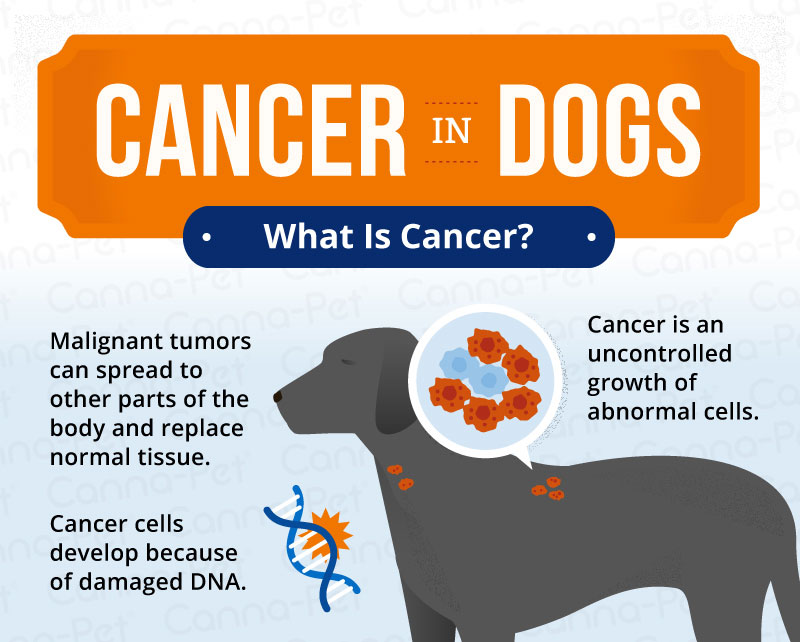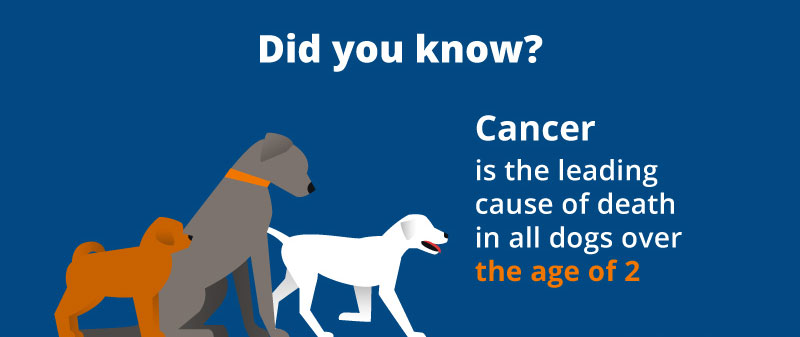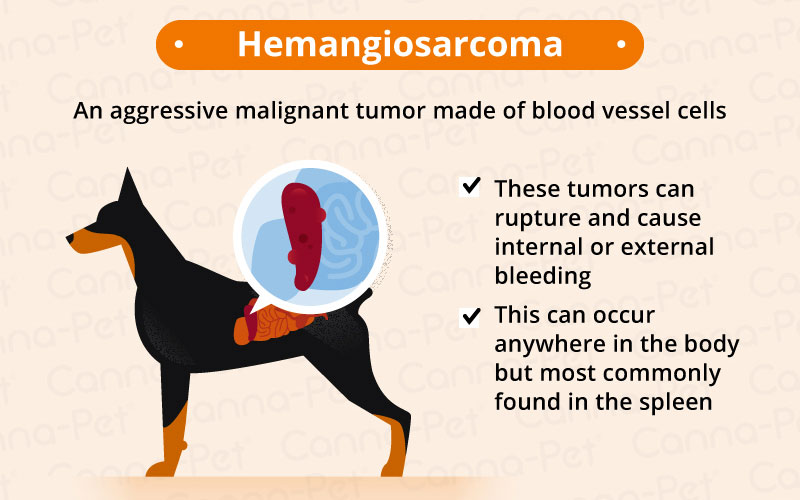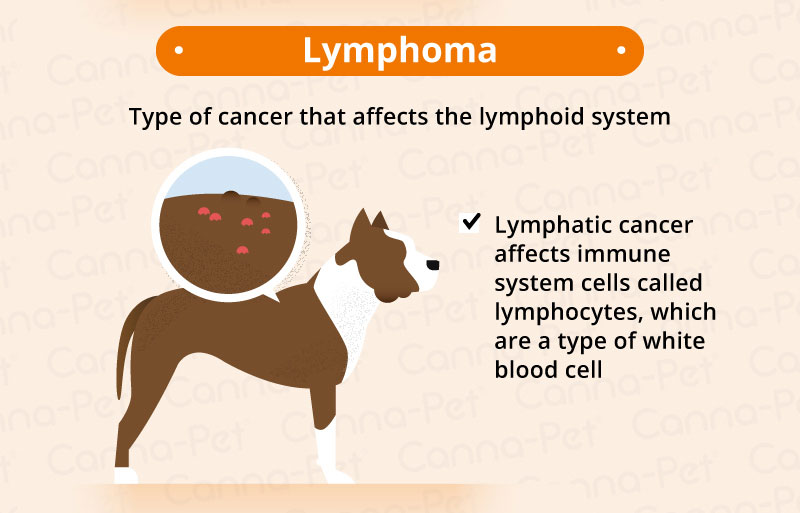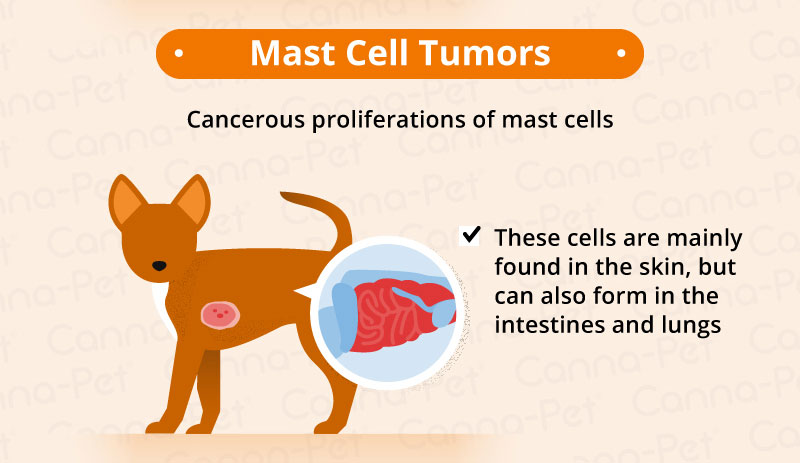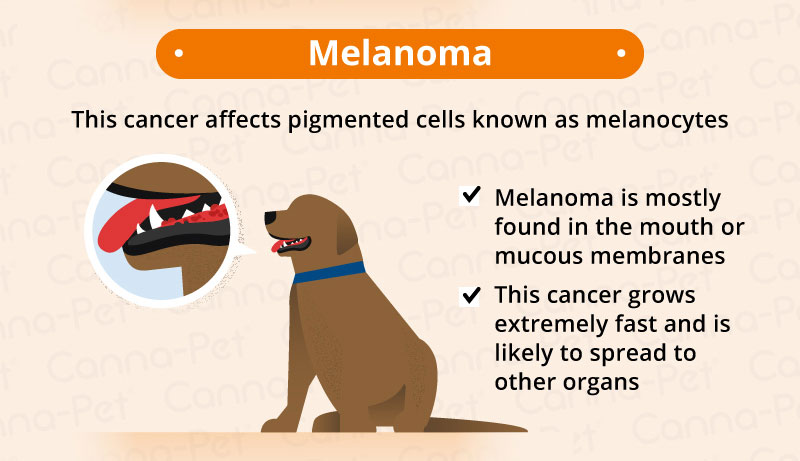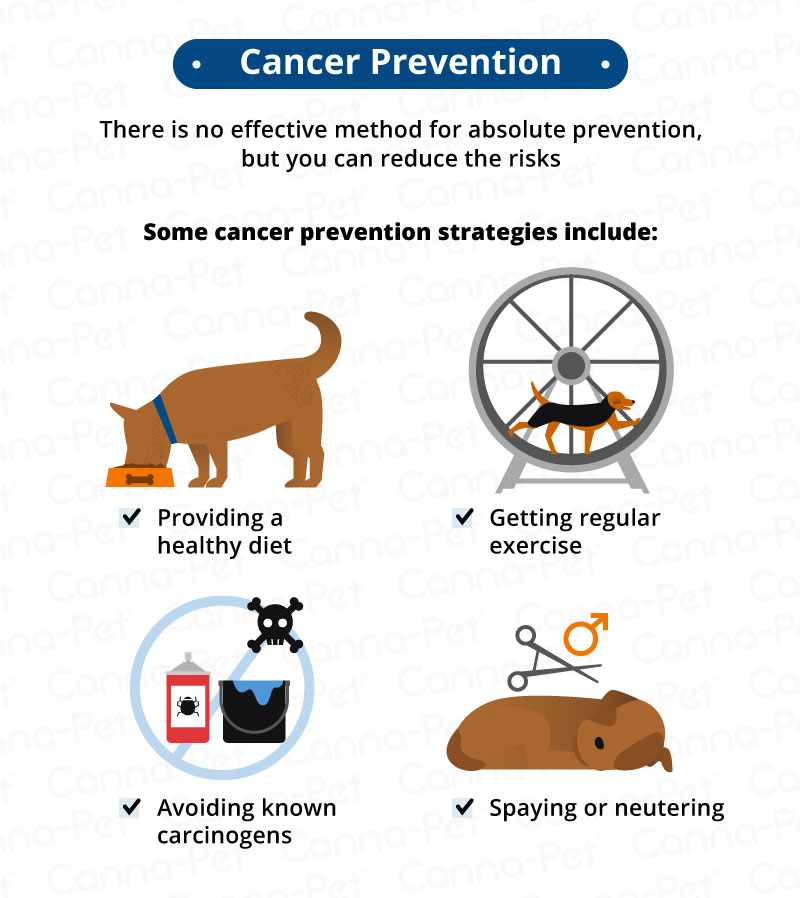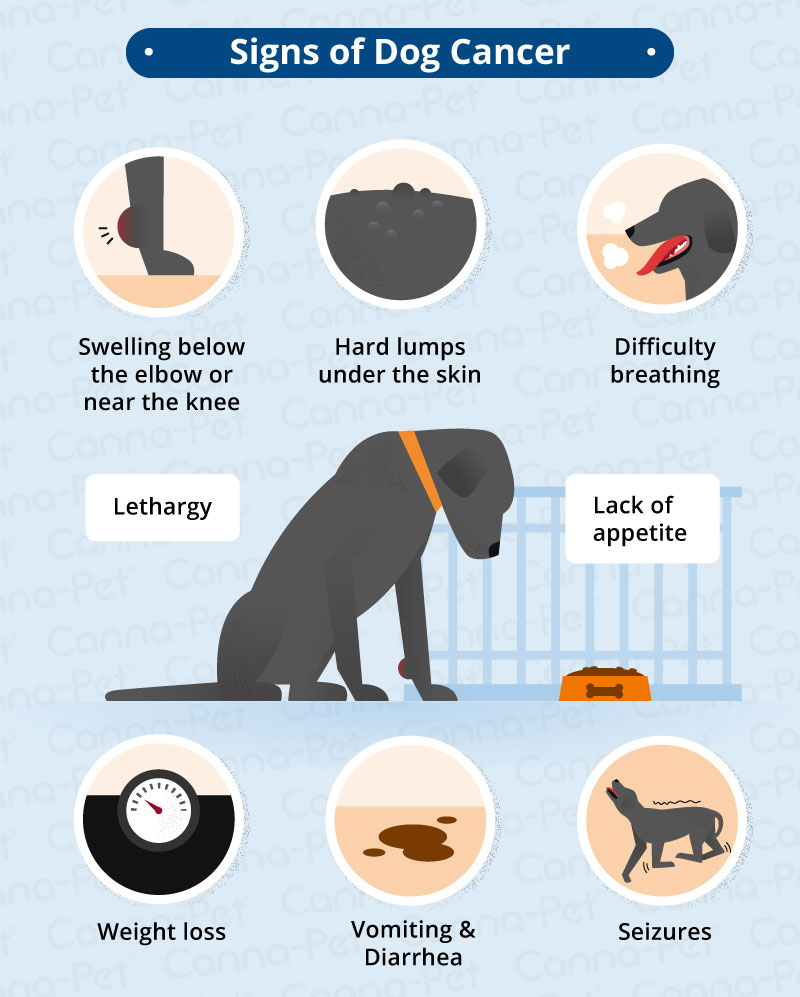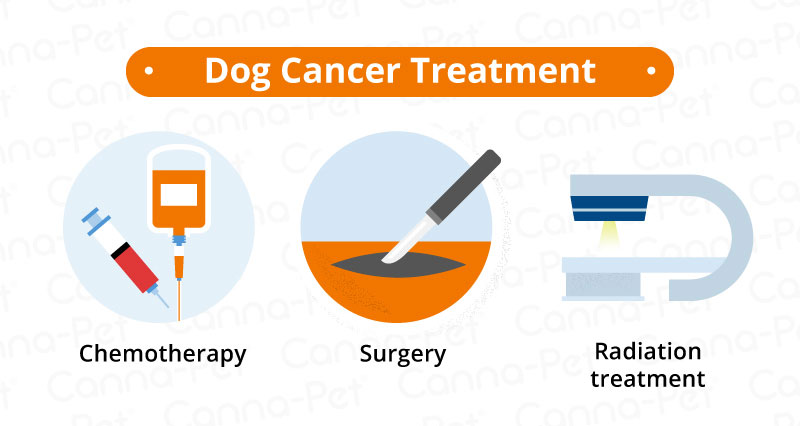You might not be worried about your dog getting cancer at some point in his life, but unfortunately, it might happen. In fact, cancer is the leading cause of death in dogs over the age of 10. Fifty percent of dogs over the age of 10 will develop cancer at some point. Therefore, it’s best to be prepared in case your pup does develop the unfortunate disease at some point in his lifetime.
What is Dog Cancer?
Cancer, regardless of the species in which it occurs, is the uncontrolled growth of abnormal cells. Cancer cells develop because of damage to DNA. Dogs can inherit damaged DNA, which accounts for some hereditary cancers. More often, though, a dog’s DNA becomes damaged by exposure to something in the environment, such as carcinogens.
Not all tumors are cancerous. Benign (noncancerous) tumors are common and do not spread to other parts of the body. With very rare exceptions, they are not life threatening. Malignant tumors, however, can spread (metastasize) to other parts of the body, where they begin to grow and replace normal tissue. Regardless of where a cancer spreads, it is usually named for the place it began.
Common Forms of Cancer in Dogs
There are dozens of different types of dog cancer, but there are several that are the prime offenders. Here’s a brief overview.
Hemangiosarcoma
Hemangiosarcoma in dogs is an aggressive, malignant tumor of blood vessel cells. A diagnosis of hemangiosarcoma is serious, with the exception of the form of hemangiosarcoma that occurs in the skin. These tumors begin in blood vessels and are frequently filled with blood. When they rupture, it can cause problems with internal or external bleeding.
Hemangiosarcoma can theoretically arise from any tissue where there are blood vessels, which is almost anywhere in the body. They most commonly appear in the spleen, but are also often found in the skin, soft tissue, or liver. Hemangiosarcomas are often highly metastatic and will frequently spread to other organs and even bones.
Lymphoma
Lymphoma (lymphosarcoma or non-Hodgkin’s lymphoma) is a malignant cancer that affects the lymphoid system. Lymphoma specifically refers to a diverse group of cancers in dogs that are derived from white blood cells called lymphocytes. These lymphocytes exist in the lymphoid system and normally function as part of the immune system to protect the body from infectious viruses and bacteria. Between 15 and 20 percent of malignant tumors in dogs are lymphomas.
Lymphoma can affect virtually any organ in the body, but mostly affects organs that function as part of the immune system. Lymphoid tissue is found in many parts of the body, including the lymph nodes, spleen, liver, gastrointestinal tract, skin, and bone marrow. Lymphosarcoma is classified according to the location in the body in which the cancer begins.
There are over 30 types of canine lymphoma, and these cancers vary greatly in their behavior. The five main types of lymphoma are multicentric (lymphoma affecting external lymph nodes), mediastinal (lymphoma involving organs within the chest, such as lymph nodes or the thymus gland), gastrointestinal (lymphoma of the stomach and/or intestines), cutaneous (lymphoma of the skin), extranodal (lymphoma affecting the chest, skin, liver, eyes, bone or mouth) and central nervous system. Multicentric lymphoma is by far the most common type of lymphoma in dogs.
Some forms of lymphoma in dogs progress rapidly and are life-threatening without treatment, while others progress very slowly and are managed as chronic, inactive diseases. But if left untreated, the cancer can be aggressive and lead to a high mortality rate.
Mast Cell Tumors
Mast cell tumors in dogs are the most common skin tumors. Roughly one third of all tumors in dogs are skin tumors, and up to 20 percent of those are mast cell tumors.
Mast cell tumors are cancerous proliferations of mast cells. Mast cells reside mainly in the skin, but are also plentiful in other parts of the body, such as the intestines and lungs. These cells fight against parasitic infection, help repair tissue, form new blood vessels, and are also connected to allergic reactions. Mast cell tumors invade and impair these functions and affect heart rate, blood pressure and more.
Although mostly found in the skin, MCTs can and will spread throughout the body, commonly appearing in the spleen, liver, and bone marrow. The danger from MCTs comes not from the tumors themselves, but the secondary damage caused by the release of chemicals that they produce.
Mast cell tumors are sometimes referred to as “the great imposters,” because there is no way to definitively identify them without a biopsy and pathology report. Although they are most frequently found on the trunks and limbs of dogs, MCTs can vary widely in their size, shape, appearance, texture, and location. Not only are they difficult to recognize, but it is also nearly impossible to predict their course. They can also range in their threat level from completely benign to aggressively malignant.
Since MCTs are so common in canines, it’s important for any dog owner to have a basic understanding of what they are and the threat level they pose to your dog.
Melanoma
Same as with people, malignant melanoma affects pigmented cells known as melanocytes. Most malignant melanomas occur on the mouth or mucous membranes, although about 10 percent are found on parts of the body covered with hair. This cancer tends to grow extremely fast and is likely to spread to other organs, including the lungs and liver.
Squamous Cell Carcinoma
Squamous cell carcinoma is a cancer that originates in the outer layer of a dog’s skin. Cutaneous squamous cell carcinomas are typically fast growing tumors that get bigger with time and resist healing. As carcinomas are malignant and particularly invasive, it is essential to have this form of dog skin cancer diagnosed and treated without delay.
Squamous cell carcinoma is often caused by exposure to the sun. Studies also show a possible connection between the papilloma virus and the development of squamous cell tumors in certain dogs.
Osteosarcoma
Osteosarcoma is an aggressive cancer that often spreads to other parts of a dog’s body. It is diagnosed in 8,000 to 10,000 dogs each year in the U.S., which accounts for roughly 85 percent of all canine bone tumors. Osteosarcoma is the most common primary bone tumor found in dogs.The cancer is so aggressive that it often requires amputation of the affected limb to provide respite from the disease. Learn more about osteosarcoma here.
What Dogs Are At Risk for Cancer?
Any dog of any breed can develop cancer, but big, older dogs are at the highest risk.
Giant and large breeds have the highest propensity for the disease. These dog breeds include Great Danes, Irish Setters, Great Pyrenees, Newfoundlands, Bernese Mountain Dogs, Doberman Pinschers, Rottweilers, Scottish Terriers, Bullmastiffs, Boxers, Basset Hounds, Airedales, Saint Bernards, German Shepherds, Bulldogs, and Golden Retrievers.
The average age for dogs to develop cancer varies based on the type of disease, but it mainly affects middle aged to older dogs.
Certain types of cancers have other common traits for development. For instance, MCTs are associated with light-colored and thin coats because they are more susceptible to sun damage, and some studies suggest that MCT development may be associated with golden or red coats. There may also be environmental factors, pre-existing illnesses, and other contributors.
What can I do to prevent my dog from getting cancer?
There is no effective method of absolute prevention, but there are things you can do that will help reduce the cancer risk for your dog. The best strategies are to feed your dog a healthy diet, provide regular exercise, and avoid known carcinogens. Spaying or neutering your dog may also reduce the risk for developing certain cancers.
Seemingly healthy, happy dogs may still develop the disease no matter what you do, but keeping them otherwise healthy will put them in the best position for a successful recovery.
Signs of Cancer in Dogs
Signs and symptoms of cancer in dogs can sometimes be hard to identify, and will vary based on the type of cancer and location, stage, etc. A veterinarian will always be the one to make a diagnosis, but there are some things you can look for.
- Swelling below the elbow or near the kneeMost canine cancers will appear as tumors under a dog’s skin. Osteosarcoma mostly develops in a dog’s limbs, so you will most often find signs below the elbow or near the knee. As the tumors usually form at or near growth plates, dogs affected by osteosarcoma will often have pronounced swelling in these areas. The swelling will cause your dog some discomfort, which is often first detected by lameness in the affected limb.
- Hard lumps under the skin
Canine lymphoma typically appears as swollen lymph nodes that feel like hard, rubbery lumps under a dog’s skin. They are generally not painful to the dog. The most common and easy-to-locate lymph nodes are under the jaw, in front of the shoulders, or behind the knee. Lymphoma can also occasionally affect lymph nodes that are not visible from outside the body, like those found inside the chest or in the abdomen.
- Vomiting & Diarrhea
When lymphoma is present in the gastrointestinal tract, vomiting, watery diarrhea, lethargy, malabsorption, weight loss, and lack of appetite are the most common symptoms. The diarrhea is often very dark in color and foul-smelling.
- Seizures
When cancer growths develop in a dog’s brain, it can often lead to seizures. Signs of a brain tumor in dogs may include abnormal behavior, vision problems, increased sensitivity to pain, or clumsy walking habits.
- Lethargy
One of the first signs of cancer in dogs can be unusual lethargy. Typically, dogs over the age of five are the most at risk to cancer. If your dog suddenly seems very tired and lethargic, this may be a sign it’s time to get him checked out.
- Weight Loss or Lack of Appetite
If you notice your dog has a sudden loss of appetite or drop in weight, it may be a good idea to visit a veterinarian.
- Difficulty Breathing
Another common form of cancer in dogs is lung cancer, which can have a significant impact on a dog’s ability to easily breathe.
Other Considerations:
Cutaneous lymphoma (affecting the skin) can present itself in many different ways, including single or multiple lumps in the skin or mouth. It tends to appear first as dry, flaky, red, itchy patches of skin anywhere on the body. When cutaneous lymphoma is found in the mouth, it often affects the gums, lips, and the roof of the mouth.
Hemangiosarcoma tumors usually develop in internal organs, so there are often no obvious symptoms before they get serious. Signs of this disease are usually the result of the tumor rupturing, which causes bleeding internally, or externally, depending on the tumor’s location. Hemangiosarcomas can also lead to difficulty breathing, abdominal swelling, seizures, abnormal heart rhythms, collapse, and depression.
Dog Cancer Treatment
If your dog is diagnosed with cancer, you and your veterinarian will put together the best treatment plan for your dog. Success of the treatment depends on the type and stage of the dog cancer. Some cancers can be cured, while others will be too far metastasized, and pain management is the only option with the time the dog has left.
The most common treatment for most types of canine cancer is chemotherapy. This is often conducted along with surgery and radiation treatment. Radiation treatment is often used to help improve the dog’s quality of life. However, again, it varies by the type of cancer.
Lymphoma generally only requires chemotherapy, but occasionally surgery and radiation may also be recommended.
Because osteosarcoma is such an aggressive, highly metastatic cancer, it requires an equally intensive treatment protocol. The most common course of action is an amputation of the affected limb followed by chemotherapy to catch any stray cancer cells.
The limb may be spared in rare cases where the tumor is small and in the right location, but this is rare. However, in this surgery, the affected bone is removed and replaced with a bone graft or a combination of bone graft and metal implant.
What supportive care can I offer my dog with cancer?
Many dogs that have cancer are generally middle aged or older. Age is not a disease but there often other health problems in older pets with cancer that must be managed simultaneously with the cancer. In addition, cancer can produce some problems in other organs such as anemia, kidney problems and digestive abnormalities.
The complete management of canine cancer requires consideration of supportive measures. These supportive measures can be considered in several categories: nutritional considerations, blood product support, and supplements for concurrent diseases or symptoms.
Pets with cancer require consistent, high-quality nutrition. The specific nutritional needs for pets with cancer are not completely understood. A cancer diet for dogs depends less on the brand of food and more on the ingredients and nutrients in the food you’re feeding your pet.
A poor appetite and weight loss can result from cancer in several ways. Cancer can affect appetite, smell, metabolism and the physical ability to chew or swallow. Treatment for cancer may also reduce appetite by inducing nausea or irritation to the intestinal tract. Numerous means of dealing with nutritional issues in pets with cancer now exist and this aspect of management should be carefully considered with your veterinarian.
For Information about Palliative Care and Cancer, see our follow up article.
Chumley: A Canna-Pet Success Story
Meet Chumley! A few years ago this little guy was diagnosed with cancer. Although he had undergone two surgeries, the doctors said that the cancer would come back for sure and that eventually Chumley would have to have skin grafts. The thought of even more operations upset Chumley’s owners and they decided to go a different route.
After searching alternative healing methods, Chumley’s owner found Canna-Pet. His tumors had already started to grow back when Chumley’s owner started giving him the pills in the morning and at night. To their surprise, the tumor went away within a few weeks!
Now, after three years, Chumley doesn’t have to take Pepcid or Benadryl every day. His fur parent states that whenever a tumor starts to show, they give him some Canna-Pet and it goes down. They state: “I believe Canna-Pet is why Chumley is still with us and we thank you for your tireless efforts to make it possible for consumers to have a choice in how their loved ones heal. I am in amazement at how well this product has worked.”
Reviewed By:  Caroline Coile, Ph.D.
Caroline Coile, Ph.D.
Caroline Coile is the best-selling author of Barron’s Encyclopedia of Dog Breeds, an inductee in the Dog Writers Association of American Hall of Fame and winner of eight Maxwell Medallion Awards. She writes the monthly Breeder’s Notebook column for Dog World magazine and the bi-monthly Nutrition column for the AKC Gazette, and has served on the AKC Canine Health Foundation President’s Council. Caroline holds a Ph.D. in Psychology from Florida State University and has served as a canine consultant to the Federal Aviation Administration.
Sources:
https://pets.webmd.com/dogs/guide/dogs-and-cancer-get-the-facts#1
https://www.akc.org/expert-advice/health/cancer-senior-dogs-signs-symptoms-to-watch-for/


